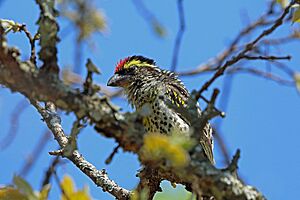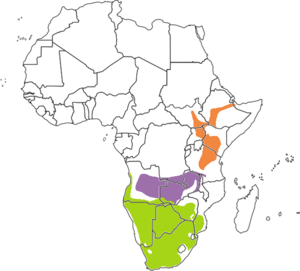Miombo pied barbet facts for kids
Quick facts for kids Miombo pied barbet |
|
|---|---|
 |
|
| Conservation status | |
| Scientific classification | |
| Genus: |
Tricholaema
|
| Species: |
frontata
|
 |
|
| Tricholaema diademata
Tricholaema frontata Tricholaema leucomelas |
|
| Synonyms | |
|
Pogonorhynchus frontatus |
|
The miombo pied barbet (Tricholaema frontata) is a cool species of bird that lives in south-central Africa. It's part of the Lybiidae family, often called African barbets. These birds are known for their bright colors and unique calls.
Contents
About the Miombo Pied Barbet
Where It Lives
This bird can be found in several countries in Africa. These include central Angola, the southern part of the Democratic Republic of the Congo, western Malawi, southwest Tanzania, and Zambia. It usually lives in places that are between 500 and 1,520 meters (about 1,640 to 4,987 feet) above sea level. The area where it lives is huge, covering about 2.49 million square kilometers (about 961,000 square miles)!
Its Home Environment
The miombo pied barbet mostly lives in thick miombo woodland. This type of forest has many trees. However, you might also spot it in more open areas. These can include woodlands that have been partly cleared or grassy spots with small groups of trees.
What It Looks Like
The miombo pied barbet is a small bird, about 16 centimeters (6.3 inches) long. It weighs between 24.5 and 28 grams (0.86 to 0.99 ounces). Both male and female birds look very similar.
Feather Colors and Markings
Adult birds have a black head with a bright red spot on their forehead. The back of their neck, called the nape, is black with white wavy patterns. Their ear feathers are brown, and they have yellow lines above their eyes. The chin and throat are white, with brown or black wavy patterns.
The bird's back is black with yellow spots. Its tail is brownish-black, and the feathers under its tail are pale brownish-grey. The main flight feathers on its wings are brown with white inner edges. Some of the inner wing feathers have white-yellow outer edges. The feathers covering its wings are black-brown with yellow tips. There are also white spots on its shoulder feathers.
Other Features
The miombo pied barbet has dark brown eyes. Its beak is mostly brown and has a small tooth-like bump. Its legs are grey-brown to grey, and its claws are pale grey. Young birds have softer feathers and do not have the tooth-like bump on their beak yet.
Behavior and Life Cycle
What It Eats
The miombo pied barbet enjoys a varied diet. It eats both insects and fruits.
Its Calls and Songs
This bird has a special song that sounds like a series of "hoop" notes. It also makes other sounds, such as "nyah," "ddddt," and "yeh" calls. When a male bird sings, it has been seen puffing out its throat and turning its head.
Reproduction
Miombo pied barbets build their nests inside holes they dig in trees or tree stumps. They usually lay their eggs between September and December. A female bird typically lays two to three white eggs at a time. Scientists don't yet know how long it takes for the eggs to hatch or for the young birds to leave the nest.
When the young birds are very small, their parents feed them insects. As they grow bigger, the parents switch to feeding them fruits. The parent birds also keep the nest clean by removing waste and seeds. Interestingly, this bird can sometimes mate with the acacia pied barbet (Tricholaema leucomelas) in southwest Zambia, creating a mixed-species offspring.
Conservation Status
Scientists don't know the exact number of miombo pied barbets in the world. Their population is slowly decreasing because their natural homes are being destroyed. However, this decline is not happening quickly enough for the species to be considered in danger. Also, the bird lives across a very large area. Because of these reasons, the IUCN Red List has listed the miombo pied barbet as a species of "least concern." This means it's not currently at high risk of extinction.


